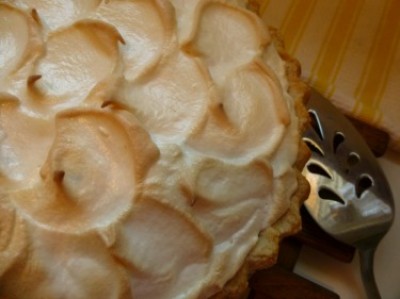Clouds of meringue float above perky, fresh lemon pudding nestled in a light crust with crunch. So many good things in one place! "Lammas" refers to the midway point between summer solstice and the fall equinox, which is when this recipe was created. And "Mama's" comes from the fact that the luscious Meyer's lemons used came from my Mom's tree!
Lammas Mama's Lemon Meringue Pie

Ingredients
Pre-baked 9” pie crust
For the filling:
1 c. sugar
1/3 c. cornstarch
Pinch of salt
3/4 c. fresh lemon juice
1 c. water
2 T. butter
4 egg yolks (save the whites)
1 t. fresh lemon zest
For the meringue:
5 egg whites at room temperature
2/3 c. sugar
1/8 t. salt
3/4 t. vanilla
Directions
For the filling:
-
In a small bowl, blend the egg yolks well with a fork. Set aside.
-
Combine sugar, cornstarch & salt in a medium saucepan with a heavy bottom. Gradually whisk in the water and lemon juice. Bring to a boil, then reduce heat and cook for 2 minutes, whisking constantly. Mixture will thicken. Remove from heat.
-
Take ¼ c. of the hot lemon mixture and whisk it into the egg yolks. Repeat. Whisk all of the egg mixture into the saucepan.
-
Cook & whisk again over medium-low heat for 2-3 minutes or until the mixture thickens.
-
Stir in the butter and lemon zest. Cook again for another minute or until the mixture is thick enough to coat the back of a wooden spoon.
-
Pour into the pre-baked crust and cover the surface with wax or parchment paper while you prepare the meringue.
For the meringue:
-
In the top bowl of a double boiler (if you’ve got one), whisk* the egg whites and sugar together. Place the bowl over warm water (over low heat) and stir continuously until the egg whites are very warm and the sugar has dissolved. Careful here! You don’t want the whites to cook, just to get nice and warm.
-
Preheat the oven broiler.
-
Transfer the egg white mixture to your mixer bowl and whip on medium-high until soft peaks form. Add the salt and vanilla and whip to combine. If you’re cooking at high altitude (3,500' or above), stop here with soft peaks. If not, carry on and whip until stiff peaks form.
-
Remove the paper from the pie filling and top with meringue. Be sure to have the meringue create a complete seal against the crust (to prevent shrinkage). Use the back of a spoon to lift the meringue into pretty little curls or decorative waves.
-
Place the pie in the broiler and – watching carefully – cook for 20 to 60 seconds, or until the meringue is golden brown.
-
Remove from oven and cool completely at room temperature and then refrigerate for another hour or two before serving.
*It's super important to make sure you're starting with a clean whisk. Any trace of fat (say from the egg yolks) on your whisk, beaters or the mixer bowl will mean that the whites won't retain air. Meringue is all about air!
Baker’s Notes and Tips and Tricks
Watch that broiling thing. It's easy for the meringue to cook too quickly and burn, resulting in a taste like charred marshmallows. I actually prefer to put the rack down a little and let the meringue cook more slowly.
The benefit of heating the egg whites in the double boiler is that it starts the cooking process, which means the meringue will be more thoroughly cooked in the end and less likely to slide around on the surface of the filling. It also helps with getting the sugar dissolved, which can reduce the appearance of those little dew-like drops on the top of the meringue ("weeping"). They don't hurt anything, it's just an aesthetic thing.
For techniques for successful prebaked crusts, check out the "Tips & Tricks" page here at Pie Pals.
Also, I hate grating zest, so this recipe has more lemon juice and less zest than most!

Rebecca Jo Dakota
05. February, 2013 | #
Hi Anne,
I'm going to add an olive oil pie crust recipe to the "crusts" category of Pie Pals. Let me say, however, that I've never made...
Anne
23. January, 2013 | #
I would beinterested to learn how to make crust with organic flour, oil and other organic alternatives. Was butter the original...
Felicia Montoya
19. April, 2012 | #
Make sure to use sweetened condensed milk and NOT evaporated milk.